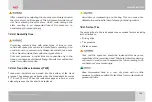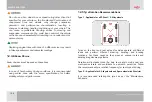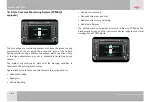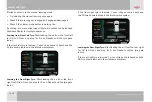
© Copyright Mahindra & Mahindra Ltd. 012016
12-9
W12L21
12.6.1 Operation of TPMS
TPMS uses wireless sensor technology that is mounted on the
wheel rim to monitor the tyre pressure levels. They transmit the
data to the receiver inside the vehicle which is in turn is
communicated and displayed on the infotainment screen and
instrument cluster.
In the infotainment screen all the tyre locations will display the
status as ‘OK’ if every tyre pressure and temperature are at
acceptable limits.
The TPMS has been customized only for the manufacturer’s
genuine tyres and wheels. TPMS pressure limits and warning
messages have been established and calibrated for the tyre size
equipped on your vehicle. Replacement of manufacturer’s parts
with a different size, type or style of components may damage the
sensor and lead to incorrect readings.
Do not use aftermarket tyre sealants or balance beads if your
vehicle is equipped with TPMS. Failure to comply may lead to sensor
damage.
The TPMS is not intended to replace normal tyre care and
maintenance or to warn of any tyre failure condition. The system
should not be used as a replacement for a pressure measuring
gauge to adjust the vehicle tyre pressure.
Driving with under-inflated tyres cause the tyres to overheat and
may lead to tyre failure. Under-inflated tyres reduce fuel efficiency,
tyre tread life and may affect the vehicle's maneuverability and
braking ability.
It is the driver's responsibility to maintain correct tyre pressure
using an accurate pressure gauge, even if under-inflation has not
reached the level to trigger illumination of the TPMS warning
indicator.
12.6.2 TPMS Warning Lamp
The TPMS warning lamp in the instrument cluster
illuminates for any alert condition and also for low/
high tire pressures warnings.
WHEELS AND TYRES
















































